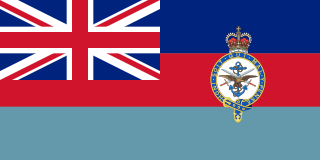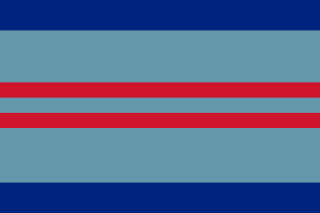Related Research Articles

Marshal of the Royal Air Force (MRAF) is the highest rank in the Royal Air Force (RAF). In peacetime it was granted to RAF officers in the appointment of Chief of the Defence Staff (CDS), and to retired Chiefs of the Air Staff (CAS), who were promoted to it on their last day of service. While surviving Marshals of the RAF retain the rank for life, the highest rank to which officers on active service are promoted is now air chief marshal. Although general promotions to Marshal of the Royal Air Force have been discontinued since the British defence cuts of the 1990s, further promotions to the rank may still be made in wartime, for members of the Royal Family and certain very senior RAF air officers in peacetime at the discretion of the monarch; all such promotions in peacetime are only honorary, however. In 2012, Charles, Prince of Wales was promoted to the rank in recognition of his support for his mother, the Queen, in her capacity as head of the armed forces (commander-in-chief), while in 2014 Lord Stirrup, who had served as Chief of the Air Staff and Chief of the Defence Staff for over seven years, was also promoted.

The Chief of the Defence Staff (CDS) is the professional head of the British Armed Forces and the most senior uniformed military adviser to the secretary of state for defence and the prime minister of the United Kingdom. The chief of the defence staff is based at the Ministry of Defence and works alongside the Permanent Under-Secretary of State for Defence, the ministry's senior civil servant. The chief of the defence staff is the British equivalent position of what in NATO and/or European Union countries is known as the chief of defence.

Air vice-marshal (AVM) is a two-star air officer rank which originated in and continues to be used by the Royal Air Force. The rank is also used by the air forces of many countries which have historical British influence and it is sometimes used as the English translation of an equivalent rank in countries which have a non-English air force-specific rank structure. Air vice-marshals may be addressed generically as "air marshal".
Marshal of the air force or marshal of the air is a five-star rank and an English-language term for the most senior rank in some air forces. It is usually the direct equivalent of a general of the air force in other air forces, a field marshal or general of the army in many armies, or a naval admiral of the fleet.

The Chief of the Air Staff (CAS) is the professional head of the Royal Air Force and a member of both the Chiefs of Staff Committee and the Air Force Board. The post was created in 1918 with Major General Sir Hugh Trenchard as the first incumbent. The current and 30th Chief of the Air Staff is Air Chief Marshal Sir Michael Wigston, who succeeded Sir Stephen Hillier in July 2019.

Lieutenant general, formerly more commonly lieutenant-general, is a senior rank in the British Army and the Royal Marines. It is the equivalent of a multinational three-star rank; some British lieutenant generals sometimes wear three-star insignia, in addition to their standard insignia, when on multinational operations.

The Air Member for Personnel (AMP) is the senior Royal Air Force officer who is responsible for personnel matters and is a member of the Air Force Board. The AMP is in charge of all aspects of recruiting, non-operational flying and ground training, career management, welfare, terms, and conditions of service, and resettlement for RAF regular, reserve, and civilian staffs worldwide.
Major General is a "two-star" rank in the British Army and Royal Marines. The rank was also briefly used by the Royal Air Force for a year and a half, from its creation to August 1919. In the British Army, a Major General is the customary rank for the appointment of division commander. In the Royal Marines, the rank of Major General is held by the Commandant General.
Air Marshal Sir Arthur William Baynes McDonald, was a senior Royal Air Force officer. He served as Commander-in-Chief of the Royal Pakistan Air Force from 1955 to 1957.
The Deputy Chief of the Air Staff (DCAS) was a senior appointment in the Royal Air Force. The incumbent was the deputy to the Chief of the Air Staff. The post existed from 1918 to 1969. Today, the Chief of the Air Staff's deputy is titled as the Assistant Chief of the Air Staff.
The Commandant of the Royal Observer Corps (CROC) was the Royal Air Force commander of the Royal Observer Corps. All the holders of the post were RAF officers in the rank of Air Commodore, initially retired reserve officers then Auxiliary officers and, since the end of World War II, serving officers. The ROC was a uniformed civilian branch initially under the control of the Air Defence of Great Britain organization, then Fighter Command and latterly Strike Command. The Royal Observer Corps existed from 1925 until it was stood down in 1995. Most of the commandants, with only three exceptions, were qualified RAF pilots, two being air navigators and the other a General Duties (Ground) Supply Branch officer. If a Royal Observer Corps officer had ever held the appointment, they would have held the rank of Observer Commodore.
The British Vice-Chief of the Air Staff (VCAS) was the post occupied by the senior Royal Air Force officer who served as a senior assistant to the Chief of the Air Staff. The post was created during World War II on 22 April 1940 and its incumbent sat on the Air Council. It was abolished in 1985 when the post's responsibilities were combined with those of the Assistant Chief of the Air Staff (Policy) and the Assistant Chief of the Air Staff (Operations) to create a single post, the Assistant Chief of the Air Staff.
Air Vice Marshal Sir Matthew Brown Frew, was a Scottish First World War flying ace, credited with 23 aerial victories, who went on to serve as a senior officer in the Royal Air Force and South African Air Force during the Second World War.
Air Vice-Marshal Hugh Granville White, was a Royal Air Force air officer. He was a First World War flying ace credited with seven aerial victories, and later went on to serve throughout the Second World War, finally retiring in 1955.
Air Vice Marshal Kenneth Malise St. Clair Graeme Leask, was a senior officer of the Royal Air Force (RAF). He began his career in the British Army and served with the Royal Flying Corps in the First World War, being credited with eight aerial victories to become a flying ace. He flew over 100 sorties, and survived three forced landings. He attained the rank of captain, and position as flight commander, in No. 84 Squadron. He remained in the RAF after the war, being appointed Director-General of Engineering in the Air Ministry with the rank of air vice marshal after the Second World War.
Controller Aircraft (CA), originally Controller of Aircraft, is a senior British Ministry of Defence appointment who is responsible for delivering an airworthy aircraft to the Services, whereupon the Service issues a Release to Service (RTS), releasing the aircraft into service. The difference between CA Release and RTS is normally one of Build Standard. Although usually held by a Royal Air Force officer, several civil servants have held the post in the 20th century. The incumbent is a member of the Air Force Board.

The Air Secretary and Chief of Staff, Personnel is the Royal Air Force officer with responsibility for appointments, promotions, postings, and discipline of high ranking members of the British Air Force. From 1978 to 1983 the Air Secretary was more often referred to as Air Officer Commanding Royal Air Force Personnel Management Centre. It is a senior RAF appointment, held by an officer holding the rank of air vice-marshal and appointed by the Queen. The Air Secretary's counterpart in the British Army is the Military Secretary. The Royal Navy equivalent is the Naval Secretary.

Air Vice Marshal George Stacey Hodson, was an air officer of the British Royal Air Force who began his military career as a World War I flying ace credited with ten aerial victories. In the course of his 34 years service, he rose to become a major commander during World War II.
References
- ↑ Barrass, M. B. (2015). "Other RAF Appointments: Commandant-Generals of the RAF Regiment". Air of Authority – A History of RAF Organisation. Retrieved 17 April 2016.
- ↑ Mackie, Colin (2016). "Royal Air Force Senior Appointments" (PDF). gulabin.com. Retrieved 17 April 2016.
- ↑ "Major-General Alfred E. Robinson". King's Collections Military Archives. Archived from the original on 4 August 2012.
- ↑ Barrass, M. B. (2015). "H T Lydford". Air of Authority – A History of RAF Organisation. Retrieved 16 April 2016.
- ↑ Barrass, M. B. (2015). "S C Strafford". Air of Authority – A History of RAF Organisation. Retrieved 16 April 2016.
- ↑ "No. 44580". The London Gazette (Supplement). 3 May 1968. p. 5183.
- ↑ "No. 45873". The London Gazette (Supplement). 9 January 1973. p. 374.
- ↑ Barrass, M. B. (2016). "D A Pocock". Air of Authority – A History of RAF Organisation. Retrieved 16 April 2016.
- ↑ "No. 47231". The London Gazette (Supplement). 3 June 1977. p. 7369.
- ↑ "No. 47835". The London Gazette (Supplement). 8 May 1979. p. 5988.
- ↑ "No. 49434". The London Gazette (Supplement). 2 August 1983. p. 10182.
- ↑ "No. 50258". The London Gazette (Supplement). 16 September 1985. p. 12794.
- ↑ "No. 51152". The London Gazette (Supplement). 15 December 1987. p. 15346.
- ↑ "No. 52031". The London Gazette . 26 January 1990. p. 1297.
- ↑ "A History of the Purchase and development of the RAF Regiment Memorial Garden at the National Memorial Arboretum". RAF Regiment Association. 2009. Retrieved 16 April 2016.
- ↑ "No. 57220". The London Gazette (Supplement). 2 March 2004. p. 2669.
- 1 2 "Air Rank Appointments List 7/06". Royal Air Force. July 2006. Archived from the original on 4 October 2012. Retrieved 16 April 2016.
- ↑ "No. 60543". The London Gazette (Supplement). 18 June 2013. p. 11992.
- ↑ "Senior Appointments". Royal Air Force. 8 February 2016. Retrieved 16 April 2016.
- ↑ "Senior Appointments". Royal Air Force. 16 November 2018. Retrieved 19 December 2018.
- ↑ "Appointment of Commandant General of the RAF Regiment". Royal Air Force. 4 May 2022. Retrieved 14 July 2022.